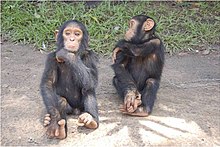Central chimpanzee
| Central chimpanzee | |
|---|---|
 |
|
| Scientific classification | |
| Kingdom: | Animalia |
| Phylum: | Chordata |
| Class: | Mammalia |
| Order: | Primates |
| Family: | Hominidae |
| Genus: | Pan |
| Species: | P. troglodytes |
| Subspecies: | P. t. troglodytes |
| Trinomial name | |
|
Pan troglodytes troglodytes Blumenbach, 1775 |
|
 |
|
The central chimpanzee or tschego (Pan troglodytes troglodytes) is a subspecies of the common chimpanzee (one of the closest living relatives to humans, along with the bonobo). It occurs mainly in Gabon, Cameroon, and the Republic of the Congo, but also, to a lesser extent, in other regions.
Pan is derived from the Greek god of fields, groves, and wooded glens, Pan. Troglodytes is Greek for 'cave-dweller', and was coined by Johann Friedrich Blumenbach in his Handbuch der Naturgeschichte (Handbook of Natural History) published in 1779.
The central chimpanzee occurs in Central Africa, mainly in Gabon, Cameroon, and Republic of the Congo, but also in the Central African Republic, Equatorial Guinea, the Cabinda exclave of Angola, south-east Nigeria, and (possibly) the coastal extension of the Democratic Republic of the Congo. Its range extends north to the Sanaga River in Cameroon, east to the Ubangi River that defines the border between the two Congos, and south to the Congo River, which defines a large part of the same border.
...
Wikipedia

